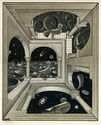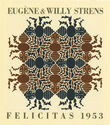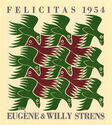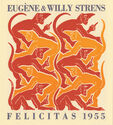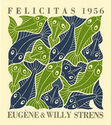
19th, 20th & 21st Century Fine Prints
707-546-7352 · fax 707-546-7924 · web: www.annexgalleries.com · email: artannex@aol.com
M.C. Escher Biography
M.C. Escher
Dutch
1898–1972
Biography
Printmaker, graphic artist, illustrator, and designer Maurits Cornelis “M.C.” Escher was born on June 17, 1898 in Leeuwarden, Friesland, the Netherlands. As a child he was frequently in poor health, and tested poorly in school as a result. Despite this, he was a talented artist and was interested in geometric designs found in nature; particularly, insects and small reptiles, which would frequently appear in his work throughout his career. He apprenticed from a young age as a carpenter, and in 1918 he attended the Technical College of Delft to study architecture. However, he soon switched to decorative arts and graphic design, attending the Haarlem School of Architecture and Decorative Arts from 1919 to 1922 where he studied under Samuel Jessurun de Mesquita.
Following graduation he traveled to Italy and Spain. This would prove to be a pivotal time for Escher, who was taken with the Moorish architecture of Alhambra Castle in Granada, and found lasting inspiration in its intricate, geometric decorative elements. In 1923 he moved to Rome, where he met and married Giulia “Jetta” Umiker, a Swiss citizen of Italian descent, with whom he would have three children. While living in Italy, Escher traveled throughout Italy and Spain to continue studying the tessellate tilework and mosaics that he’d originally found so fascinating. At this time he would create designs in the field, but as Fascism rose in Italy, he retreated more frequently into his studio, developing his own complex designs.
In 1935 the Escher family relocated to Switzerland for two years as political unrest became unavoidable. They would then move to Belgium in 1937 and, finally, settled permanently in the Netherlands in 1941, as war made it seemingly impossible for them to return to their beloved Italy. This move is widely considered the engine that drove Escher’s greatest and most well-recognized output, as he was relegated to the indoors and to the study of mathematical theory – such as rational symmetry and hyperbolic geometry - that inspired his color woodcut design.
Throughout much of his career Escher was not entirely accepted by the art world, as he was seen as more of a visual mathematical theorist (despite having no mathematical training). This did not deter him, however, and he created some of his best known pieces in relative obscurity, including “Hand with Reflecting Sphere” (1935). It wasn’t until 1950 that he gained international recognition, when he was part of an exhibition of Dutch graphic artists in Antwerp, Belgium. This led to interviews by The Studio, Life, and Time magazines in 1951, and also helped him launch a successful lecture career that took him throughout Europe. In 1954 the Inernational Mathematical Congress was held in Amsterdam, and a complementary show of Escher’s work was held at the Stedelijk Museum; this led to a show in Washington, D.C. In 1955 he was awarded the Knighthood of the Order of Orange-Nassau; twelve years later, he was made an Officer.
In the early 1960s illness kept him from traveling and creating art for several years. However, once he returned to his studio in the 1967, some of his work took on monumental proportions and he created “Metamorphosis III”, a color woodcut based on a repeated convex polygon design that measured nearly seven meters long. His final major work, a large, circular color woodcut in a rational symmetry design titled “Snakes”, was executed in 1969.
The following year Maurits Cornelis Escher moved into an artists’ retirement home in Laren, where he remained until his death on March 27, 1972. His work can be found in the permanent collections of The Hague, the Netherlands; the National Gallery of Art, USA; the Metropolitan Museum of Art, New York, USA; the Museum of Fine Arts Houston, Texas, USA; and many others.

